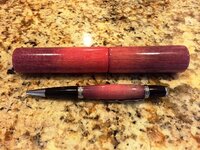You are using an out of date browser. It may not display this or other websites correctly.
You should upgrade or use an alternative browser.
You should upgrade or use an alternative browser.
Stained maple pen with case
- Thread starter Kloss
- Start date
Signed-In Members Don't See This Ad
See more from Kloss
This is nice to know. I could mount this on my goose call insert mandrel. Thanks for sharing. Really nice pen by the way.
Signed-In Members Don't See This Ad
Charlie_W
Member
Very nicely done! I like the gradient in the stain.
SteveAxelrod
Member
Sweet! Nice case!
geffre
Member
Great use of color.
But now about that case. I would like to know more about the specs on that; size, method for boring, lined with something? Etc.
Thanks Brian Geffre
But now about that case. I would like to know more about the specs on that; size, method for boring, lined with something? Etc.
Thanks Brian Geffre
Kloss
Member
Thank you guys.
I have been playing with stain and dyes for a couple of months and I am still learning.
For the gradient, after properly sanding, I just started with a black stain in the airbrush. I brought it down using some 0000 steel wool.
Did the same with the red stain that, having a white background, went towards pink.
For the cases I use maple branches with a diameter larger than 1 inch; sometimes oak.
Usually I roughly turn one part of the case, bore it with a forstner bit (I think the 3/4 of inch diameter) around 7/8 cm deep (depends on the pen style). Mount the other part on the lathe, do the same (using a smaller forstner bit, I think the half inch) and make half inch tenon to have a tight fit so I can turn the case.
I finish them separately just using scrap wood pieces mounted on the scroll chuck with 2 inches tenons.
I sand the inside with a little drum mounted on the drill press, then apply some lacquer to avoid any dust to stick on the pen. After the lacquer is cured, I glue some foam inside at the bottom of the two ends of the pen case. This will avoid the pen to travel around the case.
Please excuse my English.
I have been playing with stain and dyes for a couple of months and I am still learning.
For the gradient, after properly sanding, I just started with a black stain in the airbrush. I brought it down using some 0000 steel wool.
Did the same with the red stain that, having a white background, went towards pink.
For the cases I use maple branches with a diameter larger than 1 inch; sometimes oak.
Usually I roughly turn one part of the case, bore it with a forstner bit (I think the 3/4 of inch diameter) around 7/8 cm deep (depends on the pen style). Mount the other part on the lathe, do the same (using a smaller forstner bit, I think the half inch) and make half inch tenon to have a tight fit so I can turn the case.
I finish them separately just using scrap wood pieces mounted on the scroll chuck with 2 inches tenons.
I sand the inside with a little drum mounted on the drill press, then apply some lacquer to avoid any dust to stick on the pen. After the lacquer is cured, I glue some foam inside at the bottom of the two ends of the pen case. This will avoid the pen to travel around the case.
Please excuse my English.
liljohn1368
Member
Thank you guys.
I have been playing with stain and dyes for a couple of months and I am still learning.
For the gradient, after properly sanding, I just started with a black stain in the airbrush. I brought it down using some 0000 steel wool.
Did the same with the red stain that, having a white background, went towards pink.
For the cases I use maple branches with a diameter larger than 1 inch; sometimes oak.
Usually I roughly turn one part of the case, bore it with a forstner bit (I think the 3/4 of inch diameter) around 7/8 cm deep (depends on the pen style). Mount the other part on the lathe, do the same (using a smaller forstner bit, I think the half inch) and make half inch tenon to have a tight fit so I can turn the case.
I finish them separately just using scrap wood pieces mounted on the scroll chuck with 2 inches tenons.
I sand the inside with a little drum mounted on the drill press, then apply some lacquer to avoid any dust to stick on the pen. After the lacquer is cured, I glue some foam inside at the bottom of the two ends of the pen case. This will avoid the pen to travel around the case.
Please excuse my English.
This is nice to know. I could mount this on my goose call insert mandrel. Thanks for sharing. Really nice pen by the way.
mark james
IAP Collection, Curator
Both the pen and the case are wonderful!
Thank you for sharing, the case gives may design opportunities.
And what you did with "plain wood" is wonderful. I love local woods, and feel they have their own subtle beauty.
Great set!
Thank you for sharing, the case gives may design opportunities.
And what you did with "plain wood" is wonderful. I love local woods, and feel they have their own subtle beauty.
Great set!

